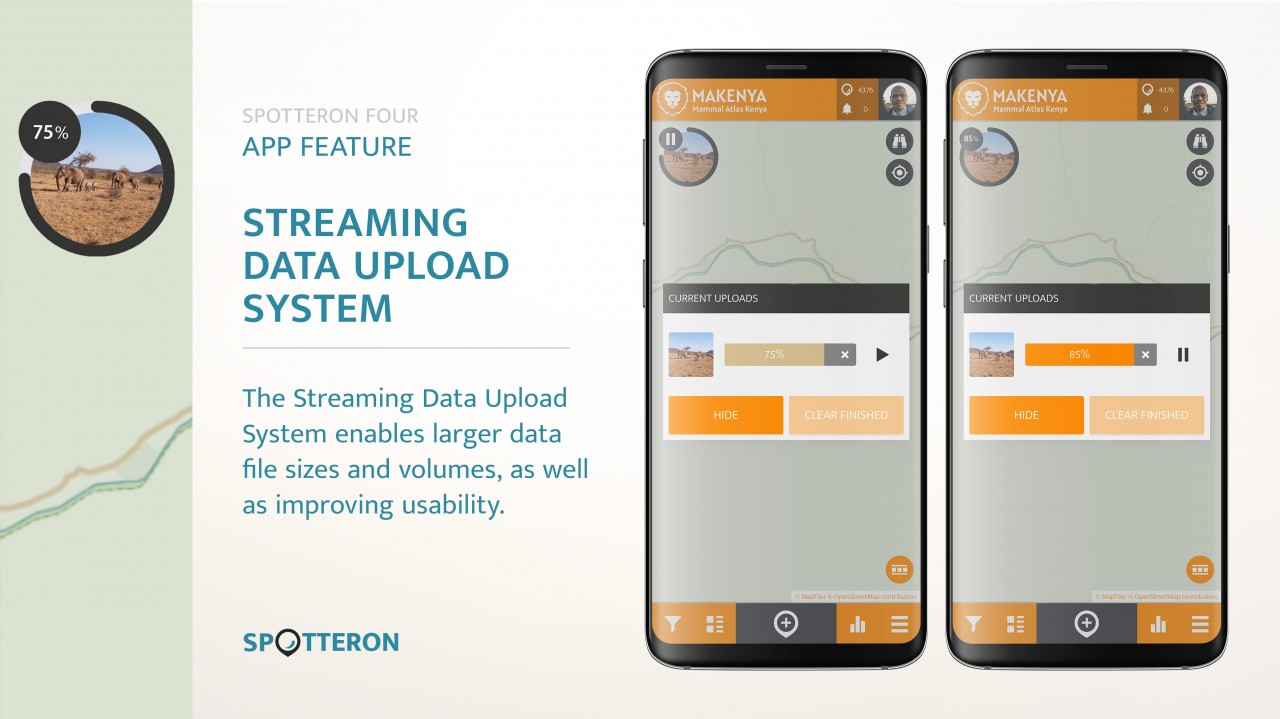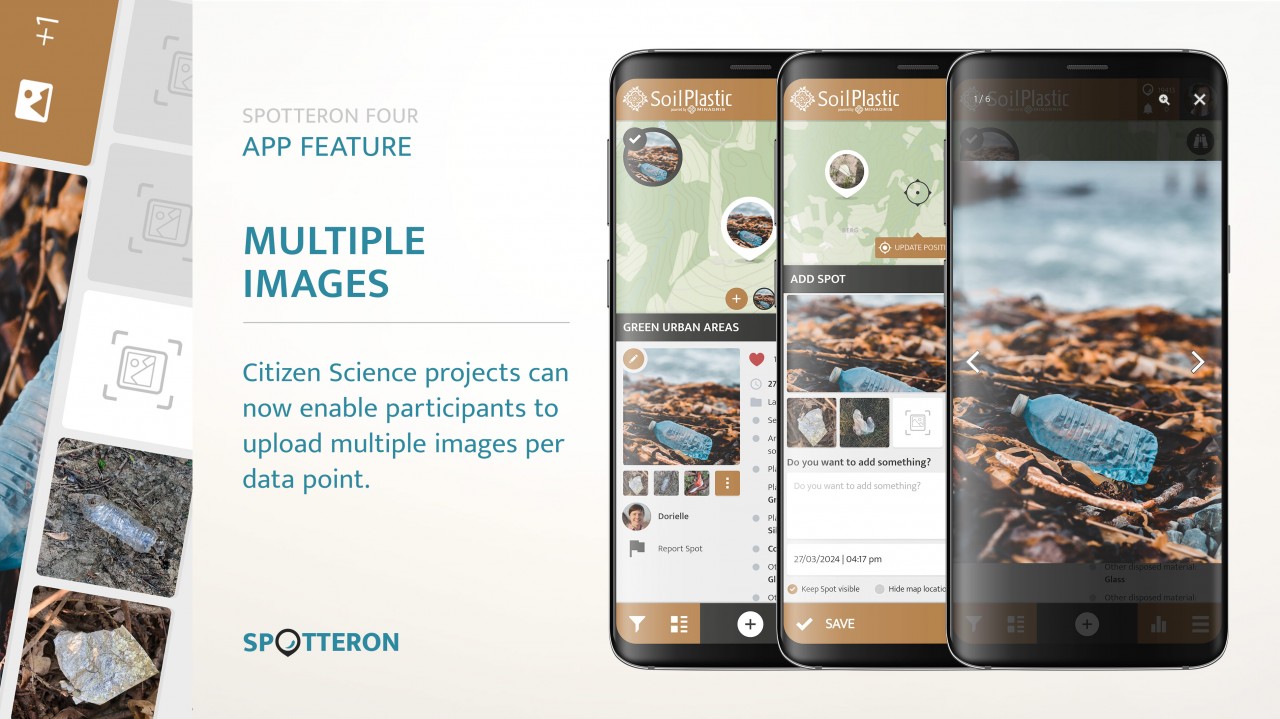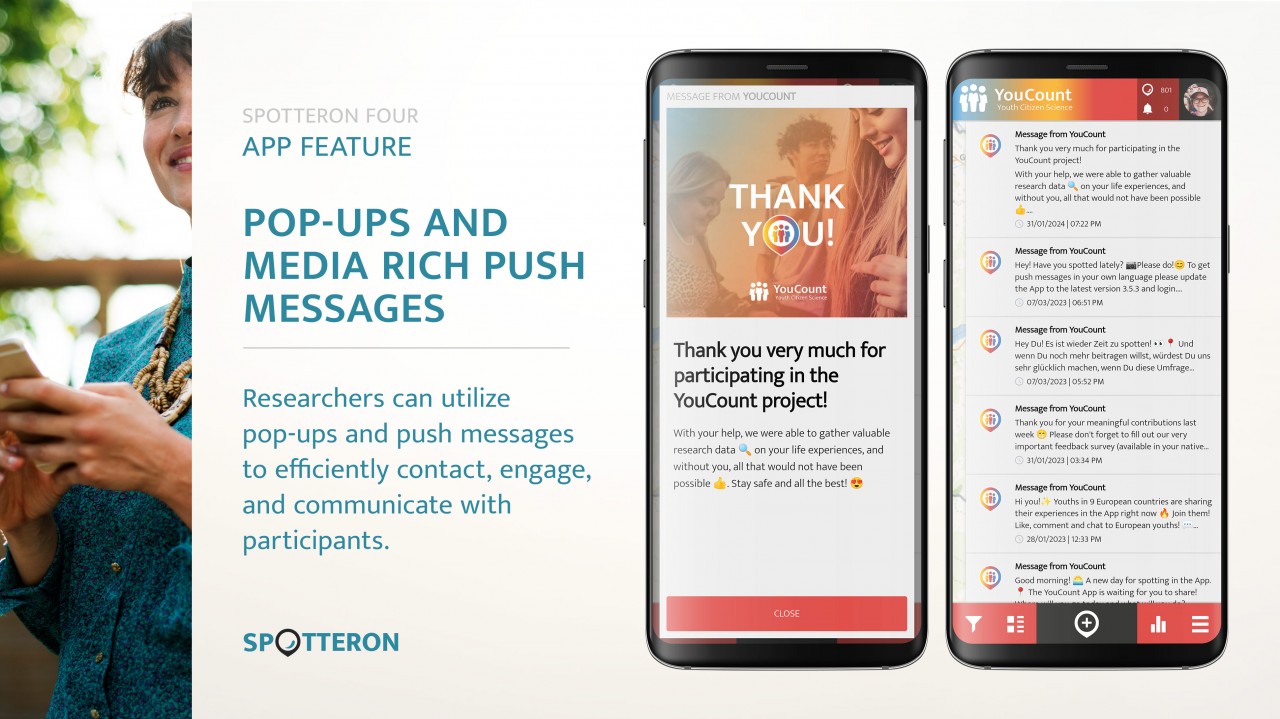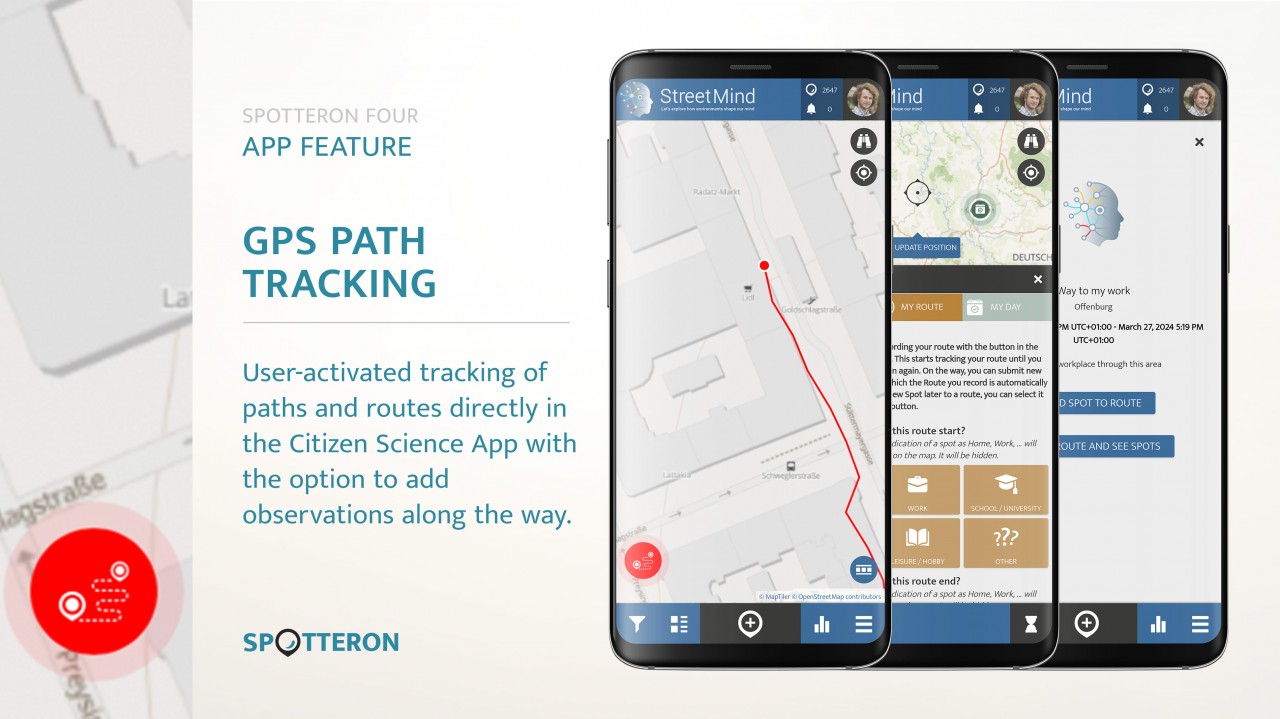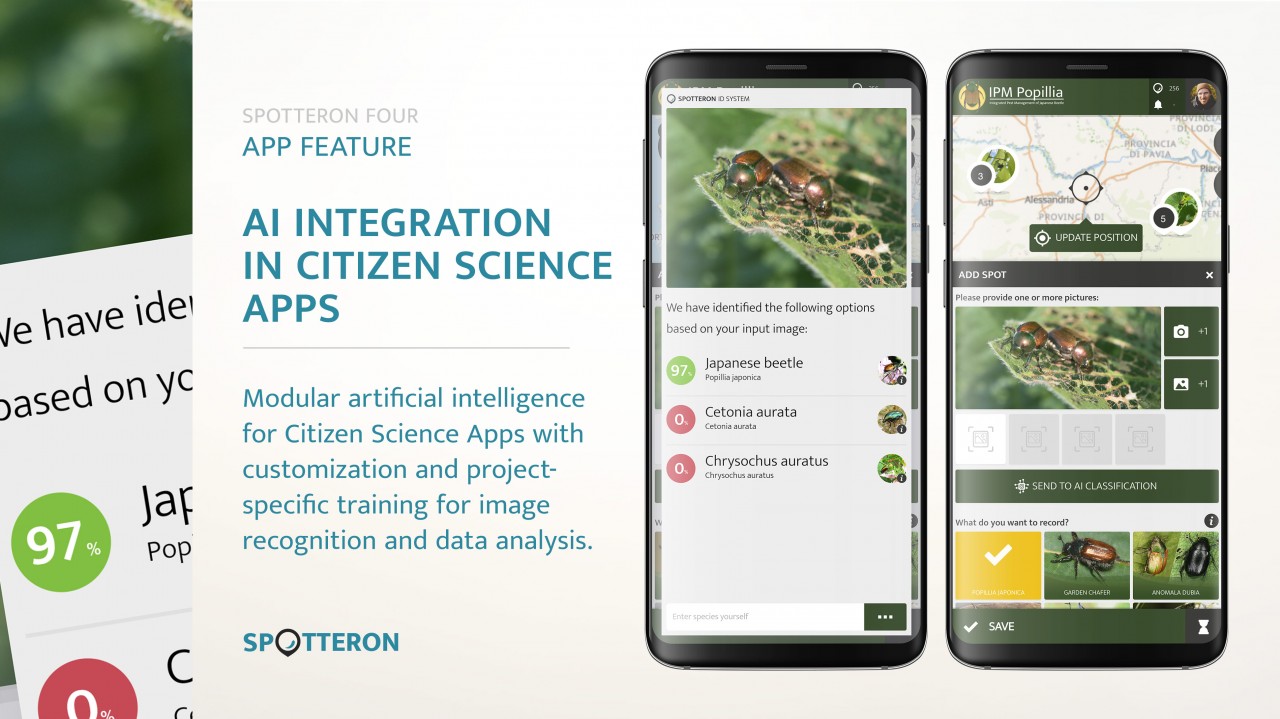SPOTTERON FOUR PREVIEW - A new generation of Citizen Science Apps is on the horizon
The SPOTTERON platform is always extending and together with projects across Europe, Australia, America, and Africa, new features and functionalities are constantly developed. With a new set of major core extensions and the overhaul of important system-related functionalities, the new platform version, SPOTTERON FOUR, brings new innovative tools and options for all Citizen Science projects.
As a preview compilation, here is a short overview of the core extensions that come with the new version. As always, all new features are available for all project Apps running on the platform without any extra development costs and can be put to use in your Citizen Science App.
New Core Features of the SPOTTERON Platform Version 4.0
Streaming Data Upload System for all Citizen Science Apps
With the new platform version, data submissions are handled differently. All Citizen Science Apps now include a "background worker", which handles uploads to the servers outside of the App itself. This enables much larger file sizes and data volumes, as well as a major improvement for usability. The new Streaming Data Upload brings a new interface for current and finished uploads to all Apps on the platform. As soon a user submits a new spot in the App, the new Streaming Data Upload is displayed in the top-left corner of the map and with a click, the new interface opens up. This new element allows the user to see the progress of the file and data transfer as well as having options to pause, stop or restart.
A major effect of the new Streaming Data Upload System is that it better handles offline situations by having the data points waiting for an internet connection. Furthermore, the total data size of a submission can be much larger, since the upload process does not block the App anymore. This paved already the way for the Audio Recording Option for Citizen Science Apps on SPOTTERON, in which file sizes of media objects are much larger than a single picture. The new Streaming Data Upload System also enables another core feature of SPOTTERON 4 - uploading multiple images per Spot.
Multiple Image Upload and Gallery Views
With the new platform, Citizen Science and Public Engagement projects now have the option to have multiple images attached to a user submission. For SPOTTERON 4, we have created a new image upload interface and extended the classic photo/picture upload box. In projects with multiple images per Spot enabled, a second line of thumbnails appears as soon as the first picture is added by the user. With adding more images to the data, the row gets filled up to a project-specific limit of maximum images. Images can also be rearranged or removed by long-pressing on the interface and drag and drop. On submitting the Spot, the project's database, the Streaming Data Upload System takes over and the data point with all media attached is dynamically uploaded via the background worker, without interrupting the usage of the App.
In addition to the data submission and processing for multiple images, SPOTTERON 4 integrates a new gallery system into the detail view of Spots. The submitted images can be viewed in an interactive gallery overlay that allows maximizing and sliding through of all objects in the gallery.
Pop-ups and Media-rich Push Messages for Communication
Communication is key in many Citizen Science and Community Science projects. For a while now, the SPOTTERON Push Message feature, which enables the project's team to send customized messages to all participations including push notifications on the users' devices, has been already part of the platform's feature spectrum. In the new platform version, SPOTTERON FOUR, we have further extended the feature with a range of new options for all projects.
Project administrators can now send not only text and emojis to the user community as push messages, but also include an image cover, a distinct title and a highlighted link to a website in the message. This enriches the quality of the SPOTTERON Push Message feature dramatically and can be used for better science communication and for keeping all participants in the loop with visually appealing updates in all project languages.
As in previous versions, the multi-language capability of the SPOTTERON Push Message is factored into all the new feature extensions. The interface in the projects' Data Administration Interface for setting up new messages has been improved to better support many project languages. There is an additional option allowing the project team to configure each SPOTTERON Push Message further. In the platform version 4, it is now possible to also set timers and send dates, repeated messages and even select countries, in which users should receive the custom message. Furthermore, the User Role feature has been integrated and allows sending messages to specific user groups in the Citizen Science App.
Finally, there is now the option to set whether a new message should be displayed as a pop-up, which every user sees on their next login into the Citizen Science App. This opens up a second unique use case to create in-App pop-up messages, informing participants deeper about the project or communicating an important message to every active user — or to simply say "Thank you" when a project milestone is reached. Pop-ups and push messages can also be combined for the best-possible outreach, having users receiving a push notification on their smartphone or tablet, and also displaying a popup on their next login.
As a direct project-to-user communication feature, the SPOTTERON Push Messages have always been a favorite feature of many project teams. Now in their extended version in SPOTTERON FOUR, they offer even more possibilities while having also the option to use a cover image.
GPS Path Tracking for Recording Live Spatial Data
Recording what path a participant takes can be a helpful component in many kinds of Citizen Science projects, from the documentation of walks to tracking excursions geographically. With SPOTTERON FOUR, your project can integrate user-activated GPS tracking as a new input option for activities. The Path Tracking feature is completely in the user's control via a new interface, that manually allows the start of the recording of the user's GPS track. While on the way, the user can add new data points of observations, alongside photographs, which are then linked to the GPS track data with the track ID stored. Through this non-interruptive design, it is, e.g. possible to record a route while adding observations of occurrences to it.
While actively recording, the Citizen Science App's interface does show an animated activity indicator. With a click/touch, the user can stop the GPS path recording anytime. Additionally, the active path recording is also visible in the phone's status bar and status drawer, from where it can also be interacted with. The new GPS path tracking offers a unique range of possibilities for Citizen Science projects, implemented in a privacy-safe and data-ethical way with full user control and keeping the data stored within the project only.
AI Integration in Citizen Science Apps
Another major step into the future of Citizen Science is the new SPOTTERON AI (artificial intelligence) integration for project-specific image recognition. As part of our main task in the Horizon 2020 project “IPM-Popillia”, in which we are a member of the project's consortium, developing and integrating an ethical AI in Citizen Science Apps is not only one of the biggest extensions we have yet done, but also the groundwork for advanced analysis of user-submitted images. The scope of utilization can be manifold, e.g. for species identification, image-based data analysis and more.
With the first Citizen Science AI prototype being already live in the IPM App for invasive species monitoring, the SPOTTERON AI can be custom-trained for a single project's goals and targets. In IPM, we have trained the SPOTTERON AI to be able to understand what the invasive pest species "Popillia japonica" looks like, and it can now predict with high accuracy if a beetle in a photograph is the Japanese Beetle or not. With SPOTTERON's modularity in mind, the usage of the new Image Recognition AI for Citizen Science Apps can be extended to other trainings and categories. Moreover, in terms of AI development and AI functionality, new add-ons are already planned to integrate the Multiple Image feature into the image recognition process to further improve output quality. Another planned development step is the possibility to highlight points of interest to the artificial intelligence system. The extended system for selecting points of interest (POI) in the AI interface in the App will especially benefit situations like multiple species in one photograph, e.g. with various bees or butterflies visiting one flower or fish and corals in the sea.
The topic of Citizen Science AI and using artificial intelligence for image recognition and data analysis in interactive, user-driven Apps will follow us into the year. As with data privacy, we will always have a keen eye on utilizing AI ethically, not for generating fakes, removing the need for curiosity and learning, or replacing creativity.
With SPOTTERON FOUR on the horizon, all Citizen Science Apps on the platform have new and improved tools at their disposal. Through extensions like the multiple image capability, pop-ups and media messages, or GPS route recording, the new version brings innovation and new ways to work with data and the user community. Thanks to the platform's collaborative approach at heart, all project's can build on each other and become more effective together.
If you are interested in starting your new Citizen Science App project on SPOTTERON, or want to migrate your existing App and use all platform features from the start, please get in contact with our team here:
Related Posts
By accepting you will be accessing a service provided by a third-party external to https://www.spotteron.net/


